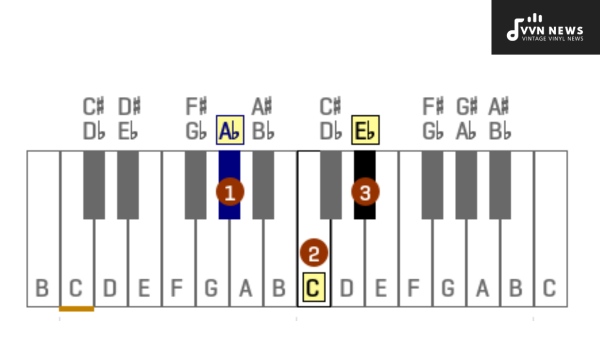Welcome to my blog post, where today we will take a deep dive into the A Flat Major Triad. If you are a musician or simply interested in learning more about music theory, this article is for you.
We will explore the structure, sound, and usage of the A Flat Major Triad in a concise yet informative manner.
The A Flat Major Triad consists of three notes: A♭, C, and E♭. By understanding the relationship between these notes and how they interact with one another, we can better comprehend the distinct sound and emotional impact of this triad.
Whether you are a pianist, guitarist, or any other instrument player looking to expand your musical vocabulary, exploring the A Flat Major Triad will undoubtedly enhance your skills and broaden your repertoire.
So let’s delve into this topic further and discover the rich possibilities that lie within the A Flat Major Triad.
What is a Triad?
In music theory, a triad is a chord comprising three different pitches, or notes. Triads are the building blocks of harmony and form the foundation of many musical compositions.
They consist of two intervals: a third and a fifth above the root note. The root note is the starting point of the triad and determines its name.
Triads can be major, minor, augmented, or diminished, depending on the intervals between their notes.
They are classified based on the number of half steps between each consecutive note within the chord structure.
Understanding triads is essential for composing, arranging, and analyzing music in various genres.
How is the A Flat Major Triad formed?
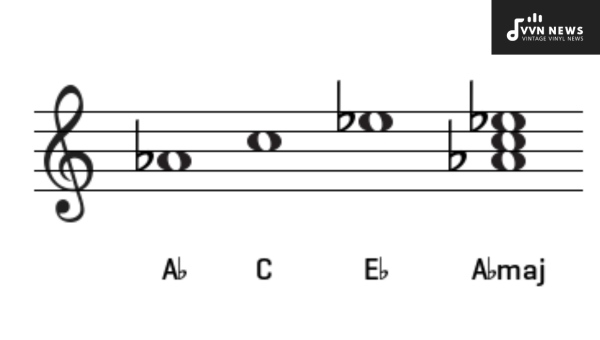
The A Flat Major Triad consists of three notes: A♭, C, and E♭. Let’s break it down step by step to understand how it is formed and what gives it its unique sound.
- The root note: The root note of the A Flat Major Triad is A♭. It serves as the foundation of the chord and determines its name.
- The major third: To form a major triad, we need to add a major third above the root note. In this case, C is a major third above A♭.
- The perfect fifth: Next, we add a perfect fifth above the root note. E♭ is a perfect fifth above A♭.
- Putting it all together: By combining these three notes – A♭, C, and E♭ – we form the A Flat Major Triad.
In terms of intervals, the distance between the root note (A♭) and the major third (C) is four half steps or two whole steps.
The distance between the root note (A♭) and the perfect fifth (E♭) is seven-half steps or three and a half whole steps.
The combination of these intervals creates a bright and uplifting sound characteristic of major triads in general.
The use of A Flat Major Triad in compositions adds depth and richness to musical pieces across various genres.
Also Read: B Flat Minor Pentatonic Scale [Create Emotive Music In Minutes]
Why is A Flat Major Triad significant in composition?
The A Flat Major Triad holds significance in composition for several reasons. Let’s explore these reasons to understand why this triad is a powerful tool for composers and musicians alike.
- Harmonic Stability: The A Flat Major Triad is considered one of the most stable and consonant chords in music. Its balanced structure creates a sense of resolution, making it ideal for establishing a tonal center and providing a strong foundation for harmonic progressions.
- Tonal Center: The A Flat Major Triad serves as the tonic, or home base, in the key of A♭ major. As the root chord of the key, it anchors the tonality and sets the framework for building melodies and harmonies within that key.
- Emotional Expressiveness: The A Flat Major Triad possesses a warm and expressive quality due to its rich harmonics. It can evoke emotions such as nostalgia, serenity, or even contemplation, making it suitable for creating delicate or reflective musical moods.
- Chord Substitutions: In composition, the A Flat Major Triad can be used as a substitute for other major chords within a piece in order to add variety and color to the harmony. This provides composers with options to create unique chord progressions while maintaining harmonic integrity.
- Modulation: Modulation refers to changing keys within a musical composition. The A Flat Major Triad can serve as a pivot chord when modulating to related keys, allowing for smooth transitions between tonalities.
- Versatility: The A Flat Major Triad is not limited to classical or traditional music genres alone; its versatility extends across various styles such as jazz, pop, R&B, and more. It can be used in both simple melodic contexts and complex harmonic arrangements.
Understanding the significance of the A Flat Major Triad in composition, musicians can leverage its stability, tonal center establishment, emotional expressiveness, chord substitution possibilities, modulation capabilities, and overall versatility.
What intervals are in the A Flat Major Triad?
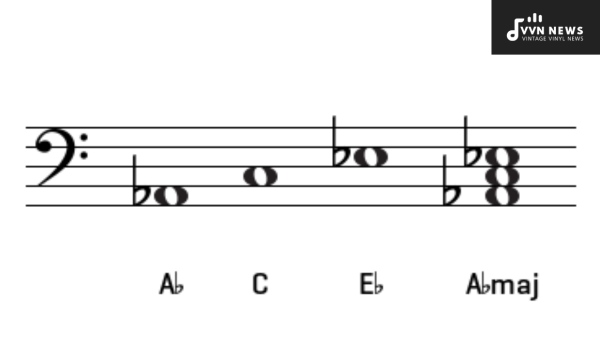
The A Flat Major Triad consists of three notes: A♭, C, and E♭. Each note contributes to the overall color and sound of the triad.
The intervals involved in this triad are crucial for grasping its structure and potential for harmonic motion.
- Root (A♭): The root note serves as the foundation and gives the chord its name.
- Major third (C): The major third interval creates a happy and bright quality to the chord.
- Perfect fifth (E♭): The perfect fifth interval adds stability and richness to the overall sound.
The intervals within the A Flat Major Triad are a root, a major third above the root note, and a perfect fifth above the root note.
These intervals work together to create a balance between stability and brightness in musical compositions.
Also Read: A Flat Minor Pentatonic Scale [Unleash Subtle Tension In Your Music]
How to Play A Flat Major Triad on Piano and Guitar
Learning how to play the A Flat Major Triad on piano and guitar is a fundamental skill for any musician.
This triad can be utilized in a wide range of musical contexts and is an essential building block of music theory. Let’s take a look at how to play this triad on both instruments.
On Piano
To play the A Flat Major Triad on the piano, follow these steps:
- Locate the A♭ note.
- A♭ is two black keys to the left of middle C (C4).
- Skip one white key to find the C note.
- Skip another white key to find the E♭ note.
- Play these three notes simultaneously, either with your thumb, index, and middle finger (right hand) or your pinky, ring finger, and middle finger (left hand).
Congratulations! You have just played the A Flat Major Triad on the piano.
On Guitar
Playing the A Flat Major Triad on guitar involves a different finger positioning technique. Follow these steps:
- Find the A♭ note.
- On the guitar, this note can be played by pressing down on the 4th fret of the G string (3rd string).
- Place your index finger on that fret.
- Skip two frets and use your ring finger to press down on the 6th fret of the B string (2nd string) to play the C note.
- Skip one more fret and use your pinky finger to press down on the 6th fret of the high E string (1st string) to play the E♭ note.
Keep in mind that these are just a couple of possible ways to play this triad on each instrument, and there are different fingerings you can explore.
Experimenting with various fingerings can expand your playing abilities and provide different voicings for the A Flat Major Triad.
Practice diligently and strive to increase your proficiency in playing this triad in different positions and inversions.
This will give you greater versatility when it comes to incorporating it into your compositions or improvisations.
Now that you know how to play the A Flat Major Triad on both piano and guitar, try incorporating it into your practice sessions and explore its possibilities in your musical creations.
Also Read: G Flat Minor Pentatonic Scale [Interesting Tones For Your Music]
Common Chord Progressions with A Flat Major Triad
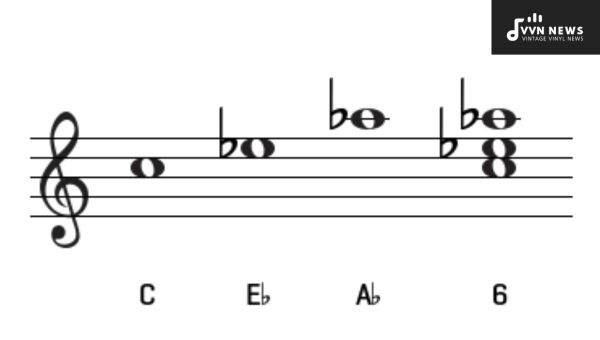
Chord progressions are sequences of chords that form the backbone of a musical piece. They create tension, release, and convey emotion.
A Flat Major Triad can be used in various chord progressions across different genres. Here are some common chord progressions that include the A Flat Major Triad:
- I – IV – V Progression: This is one of the most basic and widely used chord progressions in music. In the key of A♭ major, it would consist of the chords A♭ major (I), D♭ major (IV), and E♭ major (V). This progression creates a sense of resolution and stability.
- ii – V – I Progression: This progression adds more complexity to your composition. In the key of A♭ major, it would include the chords B♭ minor (ii), E♭ major (V), and A♭ major (I). The ii – V – I progression is commonly found in jazz music and provides a smooth transition from one chord to another.
- iii – vi – ii – V Progression: This is a common progression found in many pop songs. In the key of A♭ major, it would consist of C minor (iii), F minor (vi), B♭ minor (ii), and E♭ major (V). This progression adds variety and interest to your composition.
- I – vi – IV – V Progression: Another popular chord progression, often used in contemporary pop music. In the key of A♭ major, it would include A♭ major (I), F minor (vi), D♭ major (IV), and E♭ major (V). This progression creates a catchy and uplifting feel.
Chord progressions are an essential skill for any musician, as they provide the foundation for harmonizing melodies and creating memorable compositions.
How to recognize A Flat Major Triad by ear?
Recognizing a triad by ear is an essential skill for any musician. It allows you to identify chords and progressions in a piece of music without relying on sheet music or chord charts.
Here are some tips to help you recognize the A Flat Major Triad by ear:
- Listen for the distinct sound: The A Flat Major Triad has a bold and powerful sound that can evoke different emotions depending on how it’s used in a musical context. Pay attention to the overall character of the chord and listen for its major quality.
- Identify the root note: Find the note that anchors the triad, which in this case is A♭. This will serve as your starting point when identifying the rest of the notes in the chord.
- Recognize the major third interval: A major third interval consists of four half steps or two whole steps. In the A Flat Major Triad, you will hear this interval between the root note (A♭) and the third note (C).
- Notice the perfect fifth interval: The perfect fifth is seven-half steps or three and a half steps above the root note. In this triad, you will hear this interval between A♭ and E♭.
- Practice with reference songs or melodies: Familiarize yourself with songs that prominently feature A Flat Major chords or melodies containing these notes. This will help train your ear to recognize their specific tonal qualities.
By training your ear consistently and actively listening for these characteristics, you will develop a keen sense of recognizing the A Flat Major Triad effortlessly in any musical piece.
Also Read: D Flat Minor Pentatonic Scale [Spice Up Your Melodies Today]
Famous Pieces with A Flat Major Triad
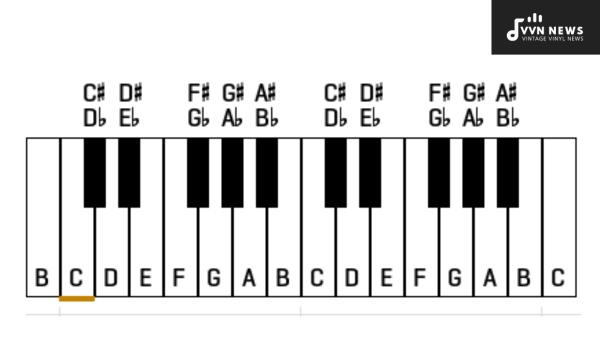
The A Flat Major Triad is a versatile chord that has been utilized in numerous musical compositions across various genres.
Here are a few famous pieces where the A Flat Major Triad takes center stage:
- Ludwig van Beethoven – Piano Sonata No. 14 “Moonlight Sonata”: In the iconic first movement of the Moonlight Sonata, Beethoven incorporates the hauntingly beautiful A Flat Major Triad in its opening bars. The triad sets a melancholic and introspective tone for the rest of the piece.
- Frederic Chopin – Nocturne in E-flat Major, Op. 9, No. 2: Chopin’s Nocturne in E-flat Major showcases delicate and expressive piano writing. The A Flat Major Triad appears throughout this piece, adding depth and richness to its romantic and lyrical melodies.
- Richard Wagner – Tristan und Isolde: Wagner employs the A Flat Major Triad extensively throughout his opera Tristan und Isolde. Particularly notable is the Prelude to Act One, where an ethereal orchestral chord progression featuring the A Flat Major Triad sets the stage for emotional intensity and longing.
- Louis Armstrong – What a Wonderful World: In this beloved jazz standard, Armstrong incorporates the A Flat Major Triad into his iconic trumpet solo. The uplifting and optimistic qualities of this triumphant triad perfectly complement the song’s timeless message of hope and positivity.
- John Coltrane – Giant Steps: John Coltrane’s composition “Giant Steps” is known for its complex harmonic structure. The A Flat Major Triad is just one of many colorful chord progressions that make up this jazz masterpiece, showcasing its versatility in creating sophisticated and harmonically rich music.
These famous compositions demonstrate the widespread usage of the A Flat Major Triad in various musical genres, from classical to jazz.
Its ability to evoke different emotions and add depth to a composition is remarkable.
What are A-Flat Major Triad Inversions and Their Application on Guitar and Piano?
Triad inversions refer to different positions or arrangements of the notes within a triad. Inversions change the order of the notes without changing their pitch classes. This alters the voicing and texture of the chord, leading to different harmonic qualities.
For the A Flat Major Triad (A♭-C-E♭), there are three possible inversions:
- Root Position: The root note (A♭) is in the bass, with C and E♭ stacked above it. This is the most common and stable form of the triad.
- First Inversion: The third note (C) becomes the bass, while A♭ moves up an octave and E♭ remains unchanged. The interval between C and the next highest note (E♭) is still a third, but inverted.
- Second Inversion: The fifth (E♭) is now in the bass, with A♭ above it and C on top. Again, this changes the intervals within the triad.
These inversions offer unique voicings that add variety to your playing or compositions on both guitar and piano.
Using Guitar:
To play A Flat Major Triad in root position on guitar:
- Place your first finger on the 4th fret of the low E string (A♭).
- Your third finger goes on the 6th fret of the D string (C).
- Finally, use your fourth finger to hold down the 6th fret of the G string (E♭).
To play the first inversion:
- Start with your first finger barring all strings at any desired fret.
- Place your second finger on the G string two frets below your barred index finger (A♭).
- Press down your fourth finger on B string one fret below your barred first finger (D).
To play second inversion:
- Begin by barring the 4th fret with your first finger.
- Place your second finger on the A string one fret below your barred index finger (E♭).
- Finally, press down your fourth finger on the D string two frets below your barred index finger (C).
Using Piano:
On the piano, each inversion of the A Flat Major Triad can be played using different hand positions and fingerings:
- Root position: Place your right thumb (1st finger) on A♭, your middle finger (2nd finger) on C, and your pinky finger (5th finger) on E♭.
- First inversion: Position your thumb (1st finger) on C, your middle finger (3rd finger) on E♭, and your pinky finger (5th finger) on A♭.
- Second inversion: Put your thumb (1st finger) on E♭, your middle finger (3rd finger) on A♭, and your pinky finger (5th finger) on C.
By exploring these different inversions and practicing them on a guitar or piano, you can add depth to a melodic line or create interesting harmonies in your compositions.
Experiment with these inversions to find unique chord progressions or voicings that suit your musical style.
Mastering triad inversions opens up a world of possibilities for chord progressions, improvisations, and musical arrangements.
FAQs about the A Flat Major Triad
What is the significance of the A Flat Major Triad in music?
The A Flat Major Triad is significant in music as it has a powerful and emotional sound, often associated with dramatic and melancholic compositions.
How is the A Flat Major Triad formed?
The A Flat Major Triad is formed by taking the root note, which is A♭, and adding the major third (C) and perfect fifth (E♭) above it.
Can you give examples of chord progressions using the A Flat Major Triad?
Common chord progressions with the A Flat Major Triad include IV-V-I (A♭-B♭-E♭), ii-V-I (B♭m7-E♭7-A♭), and vi-IV-I-V (Fm-Db-A♭-Eb).
How do I recognize the A Flat Major Triad by ear?
The distinctive sound of A Flat Major Triad can be recognized by its characteristic blend of sweetness and melancholy, often associated with classical and romantic compositions.
Are there any famous pieces that feature the A Flat Major Triad?
Yes, several famous classical compositions feature the A Flat Major Triad prominently, including Chopin’s Nocturne in E-flat major and Tchaikovsky’s Symphony No. 5 in E-flat major.
Conclusion
The A Flat Major Triad is a powerful and versatile chord that brings depth and richness to musical compositions.
From its distinct structure of A♭, C, and E♭ to its emotional impact, the A Flat Major Triad offers musicians a wide range of possibilities.
Whether incorporating it into chord progressions, exploring different inversions, or recognizing it by ear, the A Flat Major Triad is a valuable tool in music theory.
By mastering this triad’s sound and application on instruments like the piano and guitar, musicians can enhance their skills and create captivating melodies. So go ahead, dive into the world of the A Flat Major Triad, and unleash your musical creativity.
